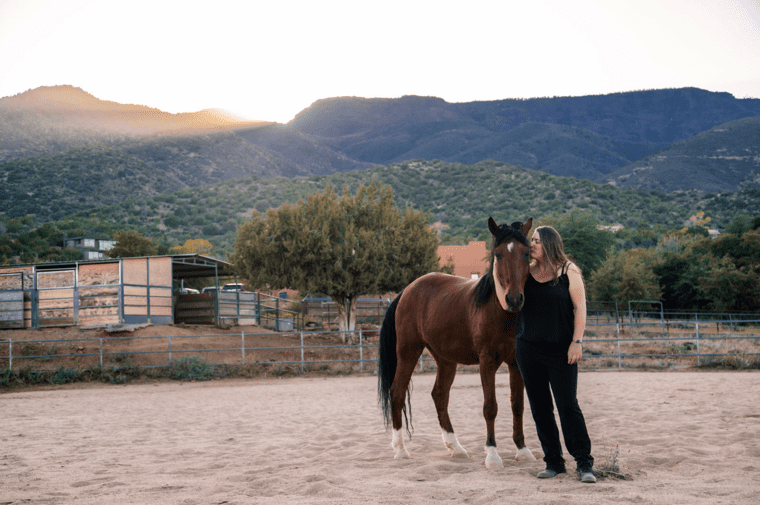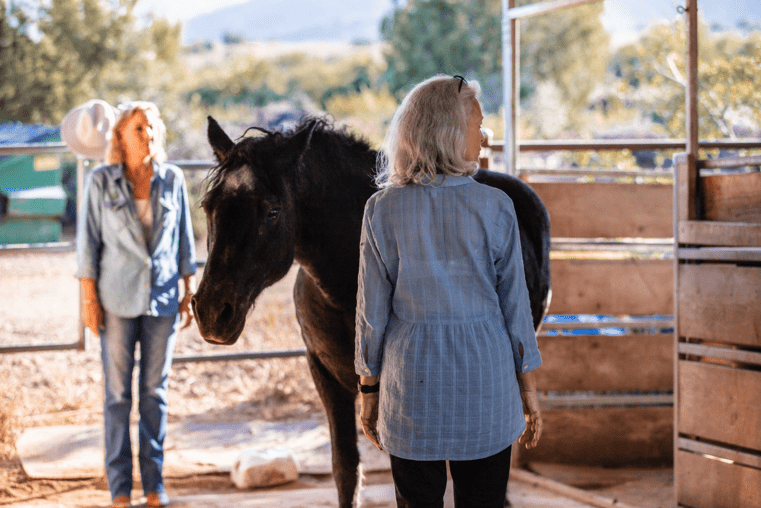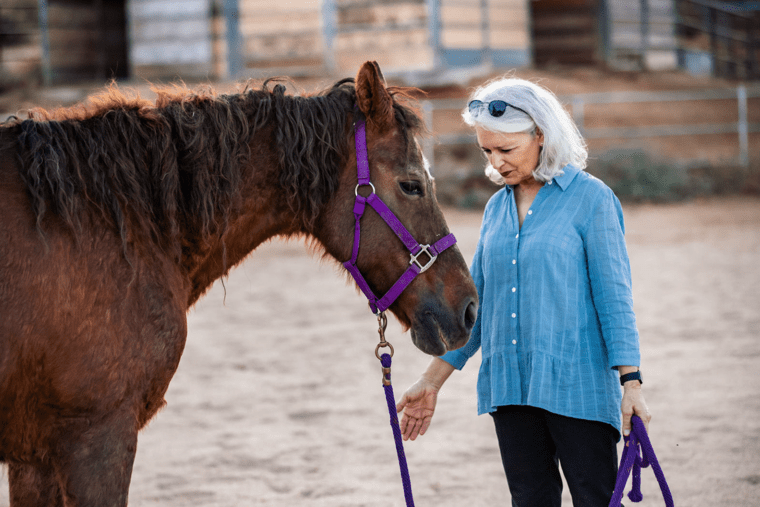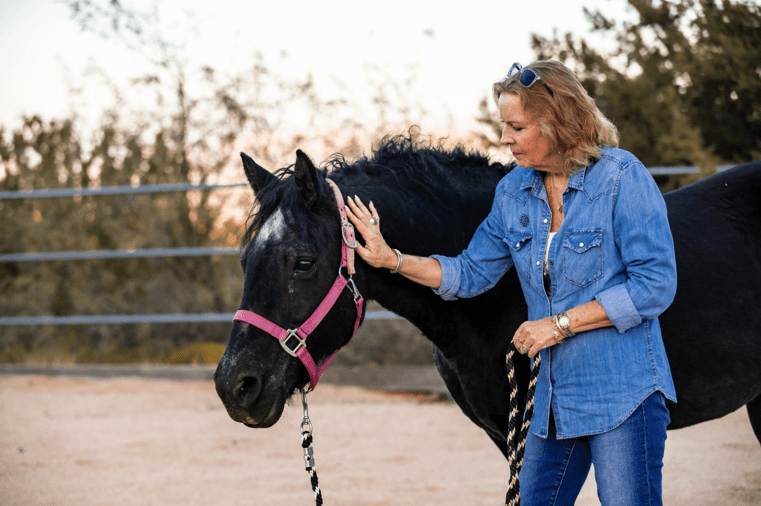
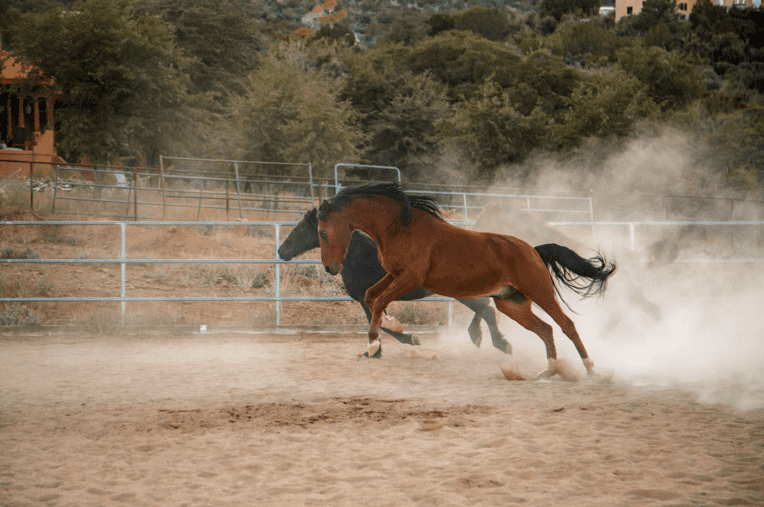
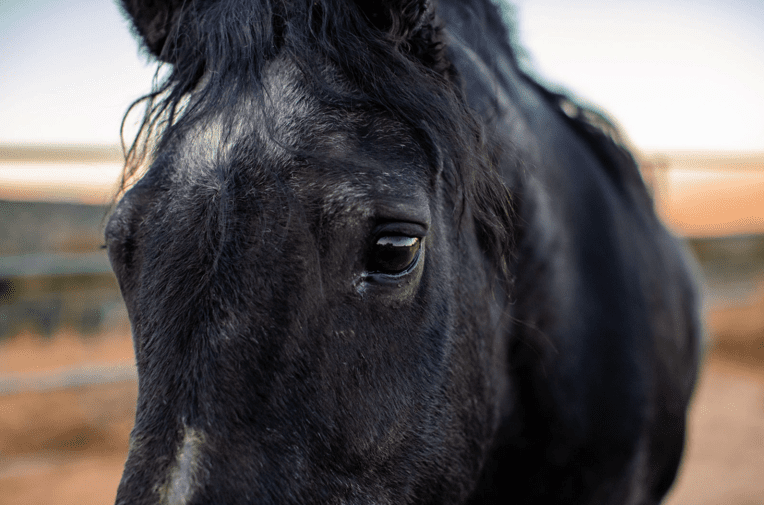
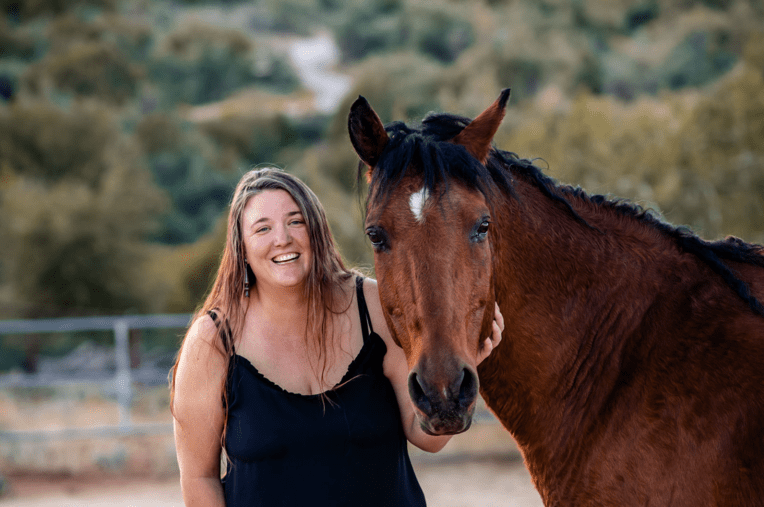
It’s a typical day in the arena. Belle, and her horse, Penny, prepare for the next client.
Belle opens the gate to allow the woman into Penny’s space, but something unexpected happens. Penny bares her teeth. Her ears pin back against her head. She lowers her head, as if to charge the woman. And Belle quickly closes the gate to separate Penny from the woman. This has never happened in the two decades that Belle and her herd have worked together.
There is a moment of confusion. Seconds earlier, when Belle had inquired about the woman’s emotional state, the woman had replied with confidence that she felt calm. So why, Belle wondered, did Penny, whom she trusted implicitly, respond to the woman in this way?
“Can you breathe underneath that feeling of calm and well-being and tell me what’s there?” Belle asked of the woman.
The woman does as she is asked and looks at Belle with surprise.
“Rage as I have never felt it,” she responds.
Belle then instructs the woman to grab her journal and begin writing through that feeling of rage. As she rapidly scribbles her resentments of past traumas onto paper, Penny draws closer. Within moments, a previously threatened horse who appeared ready to charge was now hovering over her, her neck reaching between the bars of the gate, her eyes closed in a meditative state. Her body exuded relaxation as she breathed over the woman’s head and a sense of true calm connected them to one another. In the short time that they had in the arena together, Penny was able to help the woman work through an unconscious, suppressed emotion that she had been previously stifling in order to survive.
This experience is an example of Equine Guidance®, a form of equine-based therapy established by Belle Shook, MC, NBCC, LPC, SEP, NARM, BCC. Horses have long been recognized as emotionally healing companions and there are many therapists that strive to integrate horses into their practice. Belle established Equine Guidance® in 2004 in Sedona, AZ. It has since become a destination for trauma-informed growth and healing to take place alongside her three American Bashkir Curly horses, Penny, Salsa, and Mimi. She set out to establish a program that was different than other equine therapy models; she became determined to build something trauma-informed and rooted in “being” instead of “doing.”
Belle’s existence has been intertwined with horses since childhood. From a young age, she felt a strong connection to the sizable animals. She was surrounded by other horse owners who set an invaluable example for her; that riding horses is about connection and relationship above status and showmanship. For Belle, that set the stage. She took to trail riding rather than racing or showing, and the trail was where her relationship with her horses deepened not only her connection to nature, but to herself as well. Belle reflects about her first horse, Brandy:
“She was stubborn and taught me assertiveness, respect, and perseverance. I was a pretty stubborn kid as well. She helped me to refine that as a skill as opposed to relationship rupture with authority figures.”
It was Belle’s emotional experience with her horses that set her on her professional path, and in 1998, Belle was introduced to the concept of equine therapy, a form of psychotherapy that integrates horses into the therapeutic process. Belle was immediately hooked. Every life decision from that point forward was aimed at supporting her education and expertise in the field of counseling so that she could pursue equine-based therapy as a career.
There are many equine therapy training programs available to those who are interested in integrating horses into their therapeutic practice, but not all programs are created equally, and not all programs teach a trauma-informed approach. Belle explains that, “being trauma-informed as an equine therapist is essential to the practice, because there’s a lot of work to do to avoid flooding the system with trauma.” So when Belle’s own trauma was triggered during her training, so too was her desire to seek out an effective trauma healing approach to pair with her own equine therapy practice. She couldn’t risk imparting the same traumatizing experience on her own clients.
Belle sought out every trauma training she could get her hands on, but there was still a disconnect for her, in the space between trauma healing and the healing that happened with horses. She struggled to explain how horses provided healing, and could only offer that they “read our energy fields and engage with us accordingly.” While Belle understood this intuitively, it was not very scientific or easily explained; that is, until she happened across the work of Dr. Peter A. Levine.
Learning about Peter’s work in Somatic Experiencing® (SE™) was a game changer for Belle. Through further research into SE and the neurobiology of healing, that disconnect finally resolved.
“Horses are actually reading our nervous systems!” Belle explained excitedly. “Not just our emotions, but what we are holding in our nervous system.”
This epiphany thrust Belle on the trajectory of taking the Somatic Experiencing Professional Training. She knew her work would never be complete without understanding SE in more depth. Belle even put publishing her book on Equine Guidance® on hold until she could complete the SE training. “Without SE, it felt incomplete,” Belle explained.
Belle earned her SEP certificate in 2017. Now, people travel from all over the globe to take part in Equine Guidance®. What sets it apart from other equine therapies is the trauma-informed, Somatic Experiencing elements. Belle explains that, “People are doing weekend trainings in order to become certified in equine therapy. But this work requires so much more care. Horses do not have the ability to understand a person’s limited capacity for healing in a single session. They merely see the total sum of healing needed in order to bring a person back to baseline, and often times, practitioners end up flooding their clients’ nervous systems and people end up re-traumatized.” What SE allowed Belle to bring to this process was support for her clients’ nervous systems in a gentle transformation; and rather than jumping into sessions with a “feel it to heal it” mentality, the horses are able to assist Belle’s clients with expanding their window of tolerance so that they can more than just heal: they can feel good again.
The other big difference between Equine Guidance® and other equine healing models is that Equine Guidance® is not focused on “doing” with the horses. People are not learning to ride horses or direct horses or train horses. There are no exercises or activities. They are simply “being” with the horses.
Belle explains that, “Even though it looks like a person is only standing next to a horse, worlds are happening. In that place of ‘being’ as opposed to ‘doing’, the horses are holding space for that ‘being.’ The parasympathetic nervous system is really turned on and the sympathetic nervous system is not present because we are not ‘doing’ anything with the horses.”
Belle goes on to explain with the metaphor of a tuning fork; if one were to bang one tuning fork in proximity to another, eventually the other would begin to vibrate as well. The information between the two nervous systems are “dinging” each other. That is what is happening between the horses and the clients. The horses are helping the clients’ nervous systems come back into greater coherence. They are simply holding space for the clients’ bodies to reach a place of regulation.
Dr. Peter A. Levine himself got to experience the healing that Belle’s horses have to offer when he attended an Equine Guidance® workshop with 45 other Somatic Experiencing Practitioners and workshop participants in March of 2022. During the workshop, the group entered into the arena with the horses and the horses “just did their horse thing,” standing around and being thoughtful about who they approached and when. Similarly, the participants were really supported in being curious and thoughtful about how and when to approach the horses. They were encouraged to connect into that space of ‘being’ instead of ‘doing.’ Belle reflects, “It ended up being this beautiful group experience because people were really able to drop into calm and connection. They were all blissed out at the end and people didn’t want to leave because they were in such a strong state of co-regulating with the horses and each other. Salsa laid down and people were choosing to just lay around him.” Dr. Levine himself could see that the participants had noticeable shifts in their nervous systems. They were secure and safe and were able to hold space with Belle’s impressive herd.
“It was a magical day,” Belle says. “The art of doing nothing really is something.”
Belle’s wonderful work with Equine Guidance® continues to offer healing to people worldwide. Since completing her SE training, she has finished writing her book, complete with SE-informed philosophy, and it is set to be published at the end of 2022. Belle also hosts webinars for Somatic Experiencing International. Her most recent webinar is available for rent here.
You can learn more about Belle and Equine Guidance® on her website.


